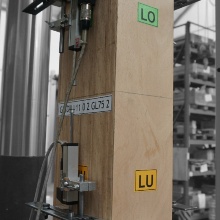Abstract
High-performance wooden structures require the selective influencing of the deformation behaviour of the joints. Innovative timber joints are made up of different "components" that can be put together according to the desired properties of the joints. The component method is appropriate for the optimisation of timber joints and for the determination of the connection stiffness, which is required above all in today's common use of computer-based methods for the calculation of internal forces and verification in the design. However, the values for the connection stiffness of dowel connections in softwood stored in the current Eurocode 5 are incomplete. For hardwoods, no systematic investigations of the deformation behaviour exist yet. This lack of knowledge concerning the deformation behaviour of timber joints, especially in the case of hardwood, represents an obstacle to the expansion of the use of timber as a material in engineering structures and impairs the competitiveness of timber construction compared to other construction methods. Especially in regard to the conversion of forests towards alternative tree species (e.g. beech), which is necessary due to climate change, the planner should be provided with the characteristic values required for the dimensioning of the connections for all kinds of wood. This is the only way to achieve the highest possible share of timber as a material in the construction industry and thus the urgent aim of a sustainable and, if possible, climate-neutral construction industry.
The aim of the project is to significantly increase the data base on connection deformation through experimental investigations on approx. 165 connections in hard- and softwoods and thus to enable a more accurate computational prediction. Above all, new materials, such as beech laminated veneer lumber (beech LVL), are to be investigated more closely in order to facilitate and accelerate their application in construction practice. By processing and making available the research results for practice and standardisation, as well as developing guidelines for an economical and safe application of stiffness in timber construction, the design of even demanding engineering load-bearing structures can be simplified.
Project Team
Universität Stuttgart
Institut für Konstruktion und Entwurf
Prof. Dr.-Ing. Ulrike Kuhlmann, Lea Buchholz
Project Funding
Holzbau-Offensive Baden-Württemberg, L-Bank
Project Term
April 1st, 2021 – June 30th, 2023



